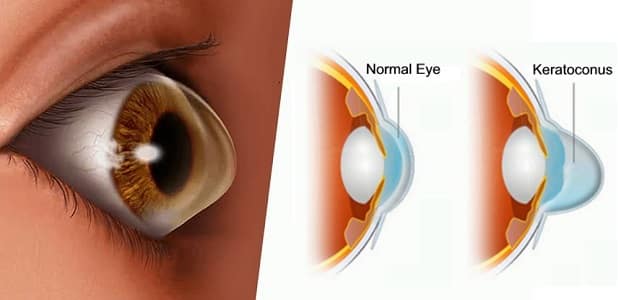Keratoconus is a condition that can be treated with the use of corneal cross-linking.
When structural reforms within the cornea occur, the cornea thins and changes shape towards a conical shape instead of the more normal progressive curve. This condition is known as keratoconus and affects the eyes. Keratoconus can cause significant distortion of sight, with numerous images, flashing, & intolerance to light all being frequently described by those who suffer from the condition.
Patients' vision can be seriously impaired when they do not receive therapy for Keratoconus or if treatment is delayed. Keratoconus is a progressive degenerative condition that can be prevented by LASIK C3R eye surgery. However, it is not capable of correcting refractive errors. Patients who have received C3R eye therapy can return to using glasses.

The price of C3R eye treatment is Rs 80000 in India, as well as the operation, takes between 20 and 30 minutes to complete. The cost, on the other hand, may vary based on the choice of the center of eye care and the ophthalmologists.
An effective C3R eye procedure has demonstrated its effectiveness in preventing the advancement of keratoconus from progressing. The first stage entails anesthetizing the cornea with eye drops to perform the procedure. The treatment is carried out in a semi-reclined seat in the clinic setting.
Patients are given high doses of antibiotics, which aid in the prevention of infection. The Daya Epithelial Disruptor can be used to disturb the mucous layer of the cornea, and afterward, Riboflavin (Vitamin B2) doses are administered into the eye once every five minutes for the next five minutes. The yellow drops are absorbed by the cornea. To determine whether or not the eye drops have indeed been absorbed, the slit lamp biomicroscope is typically employed. A clip is used to hold the eyelids open wide while the eyes are exposed to a calibrated UV device for ten minutes. After that, the clip is removed.
Patients should be aware that they must remain still throughout the entire treatment for the device to be in the proper location. When exposed to Ultraviolet light, the yellow color of Riboflavin can absorb it.
Following the conclusion of the treatment, a soft patch contact lens would be implanted in the eye, and antibiotics will indeed be injected into the eyeball. In 1 or 2 days, your contact lens would be extracted from the eye.
If riboflavin cross-linking of the corneal collagen is not performed promptly, the keratoconus may progress and the cone may become more apparent as a result. When keratoconus progresses to a later stage, it may result in a condition known as hydrops, which is water pouring into the cornea and resulting in corneal moisture.
It has the potential to cause corneal opacity as well. If this level is reached, the most likely course of action will be corneal transplantation to correct the problem.
Q1. Is Keratoconus hereditary?
Keratoconus can be hereditary in some cases. However, the case of keratoconus increases or exaggerates only with constant eye rubbing and can amplify the issue.
Q2. Can sleeping posture affect keratoconus?
Yes, sleeping position at times can affect or increase the risk factor for keratoconus. If you have a habit of sleeping on one side with your head curved inside your forearm, then this may have a risk factor for it.
Q3. Can keratoconus be reversed?
Keratoconus cases can be reversed if it is mild to moderate cases. This can be done by using procedures and treatment. The treatment will use Riboflavin for collagen cross-linking and stop the growth of the issue. A patient may also be prescribed special contact lenses as a means of ease of use. However, in advanced cases, you’ll need a full thickness C3R surgery or lamellar transplant for improving the vision and cure the issue.
Q4. How can keratoconus be diagnosed or detected?
Keratoconus can be diagnosed with the use of corneal topography which maps the cornea and helps detect the issue.
Q5. Will I go blind if I don’t treat my keratoconus?
Keratoconus typically doesn’t lead to permanent blindness but can degrade your vision and affect your lifestyle. If left untreated, it can cause hindrance in even your daily life since your entire vision periphery will be affected.
Q6. What are the precautions to be taken after C3R surgery?
After your C3R surgery, you should take a few precautions like regular use of prescribed eye drops, maintaining proper hygiene around your eyes, avoiding rubbing your eyes constantly, and to also avoid heavy activities during the first few initial days after your surgery.